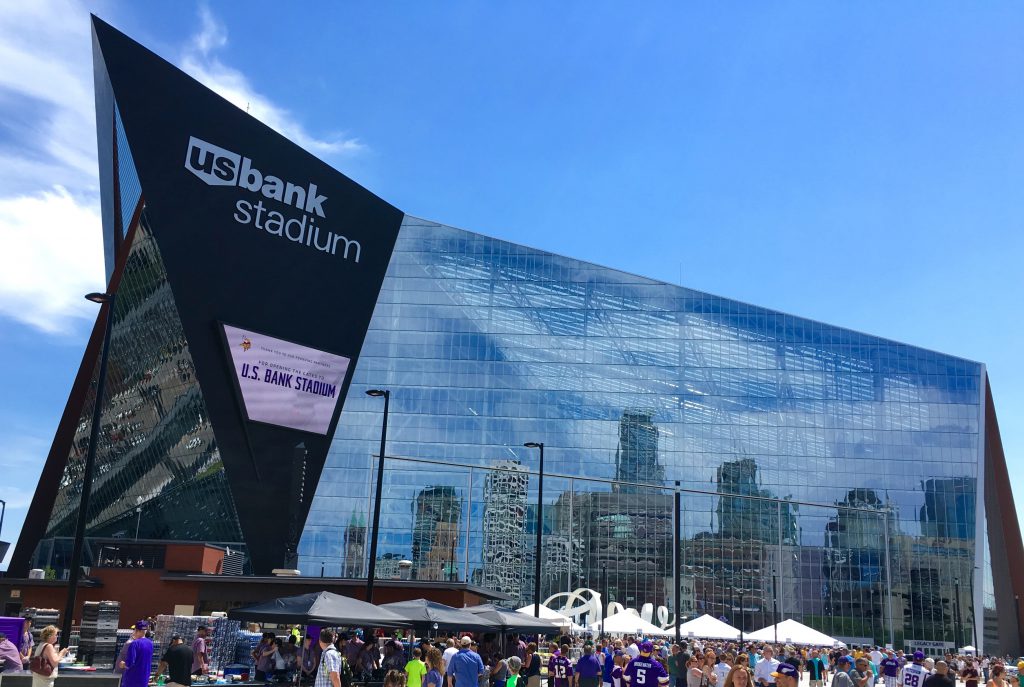
Officials used American-made steel whenever possible when constructing the landmark stadium.
MORE SUPER BOWL COVERAGE: The Super Bowl is Truly an American-made Affair, In More Ways Than One
Super Bowl LII on Sunday will feature the defending champion New England Patriots taking on the Philadelphia Eagles in Minneapolis, the northernmost city to host a Super Bowl game since Super Bowl XXVI was played at Minneapolis’ Hubert H. Humphrey Metrodome in 1992.
The NFL typically doesn’t host the Super Bowl in cold cities, but U.S. Bank Stadium changed the game plan. This marvel of stadium design allows spectators to watch the game indoors with the feel of an outdoor game, because 60 percent of the slanted, domed roof is transparent, allowing sunshine to beam through into a climate controlled environment.
So while the temperature in Minneapolis at game time Sunday is expected to be 3 degrees, it is expected to be close to 70 degrees on the field.
Home to the Minnesota Vikings during the regular season, U.S. Bank Stadium is an example of American innovation at work. It also is American-made.
The stadium, which was completed in time for the 2016 season, was built with 14,400 tons of American-made steel, and officials sourced locally made steel whenever possible. The total steel budget for the public-private funded project was $82 million, which included purchase, fabrication and erection.
Of that, $77 million went directly to American-made steel.
“Minnesota makes most of the iron ore that’s used in the United States, so anytime any project uses steel that is Made in the USA, chances are the iron ore pellets came from here. So that helps us and the American steel industry.” Cliff Tobey, steelworker
From the early planning stages, regional and local sourcing of workers and materials became a top priority. Of the nearly 250 trade partners involved in the project, more than 90 percent were Minnesota-based companies; 37 percent of the workers were minorities and 10 percent were women.
Two Minnesota companies oversaw much of the project. LeJeune Steel Company of Minneapolis did the fabrication, and Danny’s Construction Company of Shakopee completed the erection of the steel with the help of Ironworkers Local 512.
But finding the right steel for the stadium’s fixed, trademark roof was a challenge. The 60 percent ethylenetetraflouroethylene (ETFE) roof, a fluorine-based clear plastic, is the largest in the United States and needed a massive steel truss, unavailable at America’s steel mills, to maintain the stadium’s outdoor atmosphere.
ArcelorMittal, the world’s largest steelmaking company and an adamant supporter of the American steel industry, was able to manufacture this grade 65 “super beam” at its Luxembourg mill.
“There are no manufacturing plants in the United States that make grade 65 steel,” said Michele Kelm-Helgen, chairperson of the Minnesota Sports Facilities Authority. “Grade 65 steel was used for the main truss that is used for an extremely long span of the roof. The long span steel was required to be of a certain length and strength that is only manufactured in Europe.”
But Kelm-Helgen was aware of ArcelorMittal’s commitment to the American steel industry.
“ArcelorMittal owns and operates facilities on the Iron Range in Northern Minnesota – the ArcelorMittal Minorca Mines and the Hibbing Taconite Mines,” Kelm-Helgen said.
Iron ore is an essential ingredient in making steel. Cliff Tobey is a crane operator for U.S. Steel at its Keetac Mine on the Iron Range.
“I think anybody who knows anything about iron ore mining would understand that anytime we can get public infrastructure or projects that are partially funded by the public, it helps the iron ore industry up here,” Tobey said. “Minnesota makes most of the iron ore that’s used in the United States, so anytime any project uses steel that is Made in the USA, chances are the iron ore pellets came from here. So that helps us and the American steel industry.”
ArcelorMittal is heavily invested in its American operations, supporting more than 18,000 American workers at 27 U.S. facilities. In addition, the company supports Buy America preferences for domestic steel.
The purchase of the grade 65 steel came out to a cost of $5 million, which was just 6 percent of the total budget.
“The remaining $77 million was spent with domestic companies procuring additional steel for other parts of the building,” Kelm-Helgen said. “There were 14,400 tons of grade 50 steel that was manufactured and purchased in the United States.”
The stadium covers approximately 1.75 million square feet and has a regular-season seating capacity of 65,400. It will be able to seat 72,000 fans for the Super Bowl, an option that was part of the original plan.
U.S. Bank Stadium has seven levels with 116 luxury suites and 8,000 club seats with some of these prime viewing locations at field level.
The stadium project was the largest public works project in Minnesota state history. It is the centerpiece of a major redevelopment in the Downtown East area. Of the stadium projects $1.09 billion capital costs, $577 million, or 53 percent, is being paid with private funding. Taxpayers, the state of Minnesota and the city of Minneapolis will provide the remaining 47 percent of funding.
Super Bowl LII will be broadcast live on NBC with a scheduled kickoff of 6:30 p.m. Eastern time.
